Composing
7 Steps for Recording Songs Like a Pro
Hone your recording skills with these 7 steps to achieve professional sound quality – the key to taking your music to the next level.
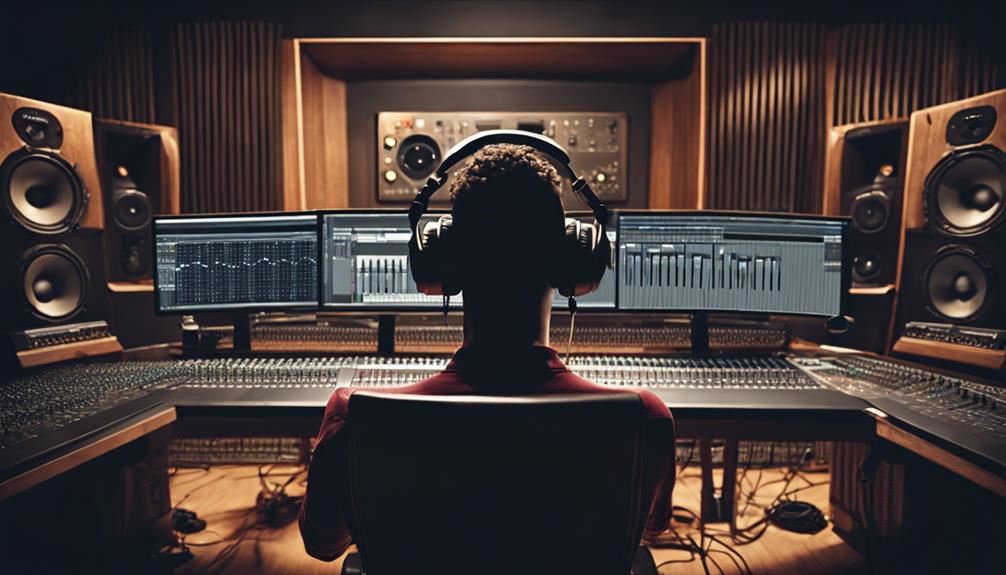
To record songs like a pro, first, create a sound-friendly space with good acoustics and proper lighting. Understand the song's details, like key and tempo, for precise recording. Optimize room acoustics with treatment placement and isolation techniques. Choose the right microphone type for vocals, considering patterns and sound quality. Prepare the vocalist with warm-ups and suitable equipment. Remember, by applying these steps meticulously, you'll elevate your song recordings to professional levels. Each detail contributes to the overall quality of your tracks, ensuring a polished finish for every song you produce.
Key Takeaways
- Optimize sound quality with a dedicated recording space and proper acoustics.
- Familiarize with song details like arrangement, key, tempo, and lyrics for precision.
- Enhance room acoustics with strategic placement of acoustic treatment.
- Select appropriate microphones based on vocal nuances and recording needs.
- Ensure vocalist's preparation with warm-up routines, exercises, and a comfortable environment.
Set Up Your Recording Space
To optimize sound quality in your recordings, we need to carefully set up our recording space. Choosing a dedicated room with good acoustics is vital.
Investing in soundproofing materials such as acoustic foam panels or bass traps can help eliminate unwanted noise and echoes, ensuring a clean sound capture. Proper lighting is essential for creating a conducive environment, while comfortable seating can enhance productivity during long recording sessions.
Organizing the equipment layout strategically not only allows for easy access but also promotes an efficient workflow. Consider incorporating ergonomic furniture to maintain comfort and reduce fatigue.
Implementing cable management solutions keeps the setup neat and organized. By paying attention to details like soundproofing, lighting, ergonomic furniture, and equipment layout, we can create a recording space that maximizes sound quality and supports a productive workflow.
Familiarize With Song Details
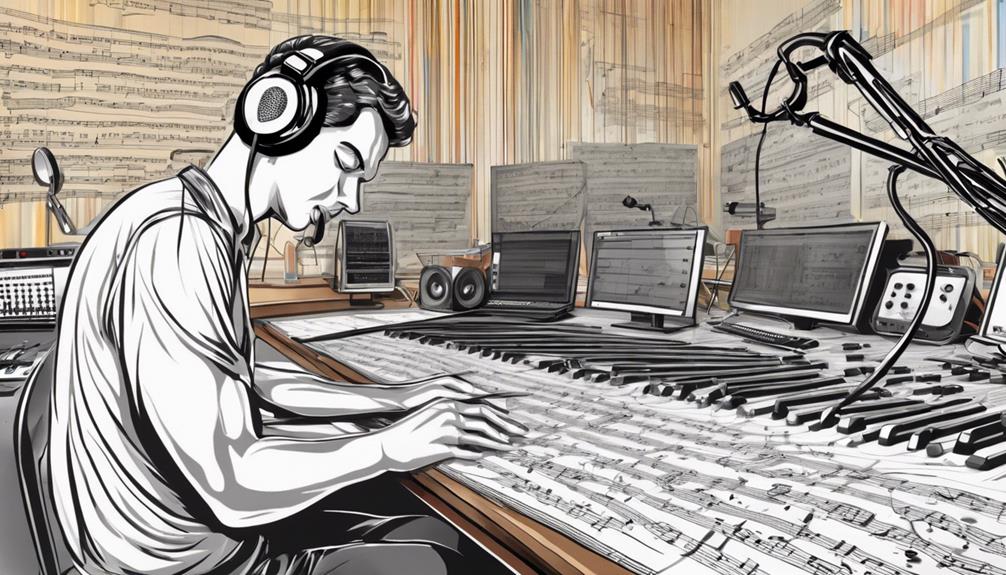
We explore the intricacies of understanding the song's arrangement, key, tempo, and lyrics to guarantee precise recording. When preparing to record a song, it's important to dive into the details that shape its essence. Here's a quick guide to familiarize yourself with the fundamental elements:
- Song arrangement: Analyze the structure of the song, including verses, choruses, bridges, and any instrumental breaks, to plan the recording process effectively.
- Key and tempo: Determine the song's key signature and tempo to make sure all instruments and vocals align harmoniously throughout the recording.
- Lyrics: Grasp the lyrical content and emotional nuances of the song to deliver a compelling vocal performance that resonates with listeners.
- Singer's vocal range: Understand the singer's vocal capabilities and range to choose suitable melodies and harmonies that showcase their strengths.
Optimize Room Acoustics
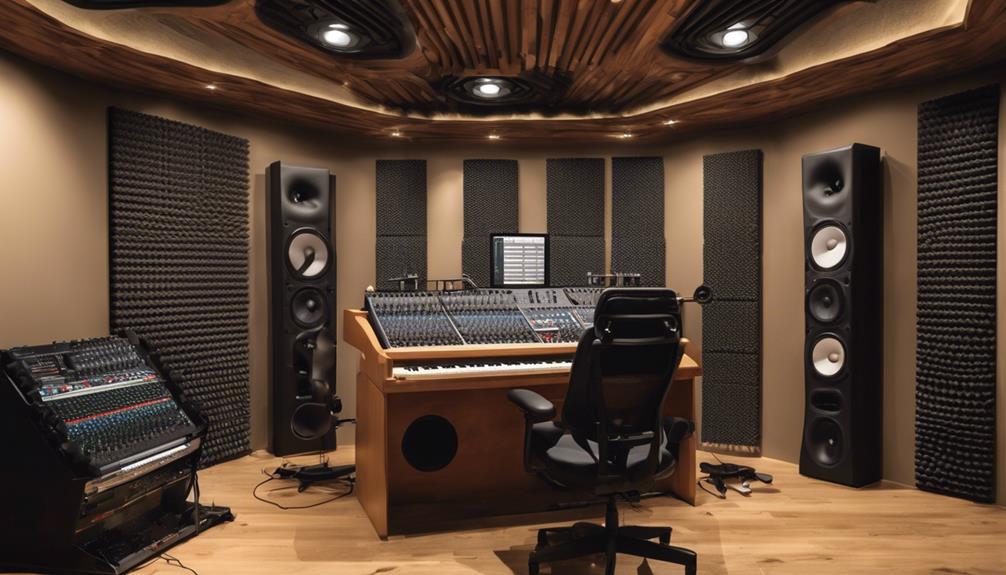
Improving sound quality in vocal recordings involves strategic placement of acoustic treatment to optimize room acoustics. By incorporating absorption panels, bass traps, and diffusers, you can effectively control room reverb and echoes, leading to a cleaner sound.
Creating a dedicated vocal booth or using an isolation shield helps isolate vocals from external noise interference, ensuring that your recordings are free from unwanted distractions. Optimizing room acoustics is essential for enhancing sound quality and clarity in vocal recordings. Address issues like standing waves and reflections by strategically positioning acoustic treatment throughout the room.
Professional acoustics play a significant role in creating an ideal recording environment for achieving high-quality vocal tracks. Remember, the proper arrangement of acoustic elements can make a substantial difference in the final outcome of your recordings. So, take the time to fine-tune your room acoustics to elevate the overall quality of your vocal recordings.
Select Proper Microphones
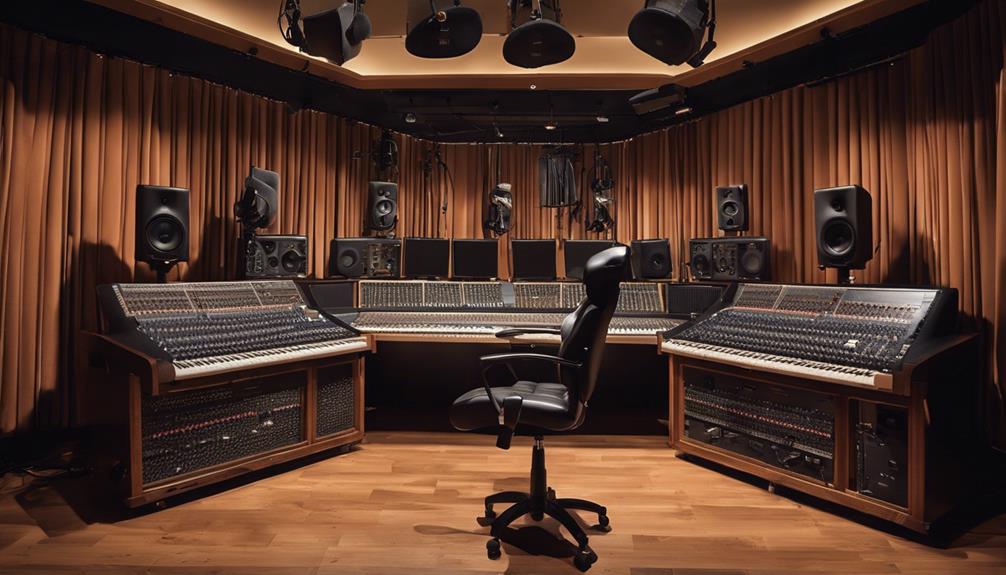
When choosing the correct microphone, it's crucial to comprehend the different types available and which ones are most suitable for vocals.
Large-diaphragm condenser microphones excel at capturing the subtleties of a singer's voice, whereas dynamic mics are ideal for live performances.
Moreover, taking into account microphone polar patterns can assist in customizing your recording setup for various situations.
Mic Types Explained
Large-diaphragm condenser microphones stand out as the top choice for capturing rich, detailed vocals with warmth and clarity. When it comes to selecting the right microphone for your recording needs, consider the following options:
- Dynamic microphones: Ideal for live performances and capturing high-SPL sources like drums and guitar amps.
- Ribbon microphones: Offer a smooth, vintage sound perfect for delicate vocals and acoustic instruments.
- Small-diaphragm condenser microphones: Excel at capturing transient details and high-frequency content with precision.
- Shotgun microphones: Highly directional, perfect for picking up sound from a specific source while rejecting off-axis noise.
Each microphone type serves a unique purpose in sound capture, enhancing the quality of your recordings and bringing innovation to your vocal recording experience.
Best Mics for Vocals
For achieving excellent vocal recordings, we always emphasize selecting the appropriate microphone that suits your voice type and recording environment. When it comes to capturing vocals, different microphones offer unique characteristics.
Large-diaphragm condenser microphones are ideal for vocals, providing warmth and detail. Dynamic microphones, often used for live performances, offer durability and feedback rejection. Ribbon microphones deliver a smooth, natural sound, perfect for vintage or intimate recordings. Tube microphones are favored in professional settings for their classic, warm tone.
While USB microphones offer convenience for home setups, XLR microphones are preferred for professional vocal recording due to their superior quality. Choose the microphone that best fits your needs to elevate your vocal recordings to a professional level.
Ensure Vocalist's Preparation

To ensure the vocalist's readiness for recording, it's vital to promote proper vocal warm-up routines lasting 15-20 minutes beforehand. This essential step can greatly improve performance and prevent vocal strain.
Here are some key factors to keep in mind in ensuring the vocalist's preparation:
- Encourage vocal warm-up exercises to enhance vocal performance.
- Provide a comfortable environment to boost the vocalist's focus during recording sessions.
- Select large-diaphragm condenser microphones for best sound capture.
- Set the input level on the audio interface correctly to avoid distortion and maintain peak levels around -10dB to -6dB.
Utilize Recording Techniques
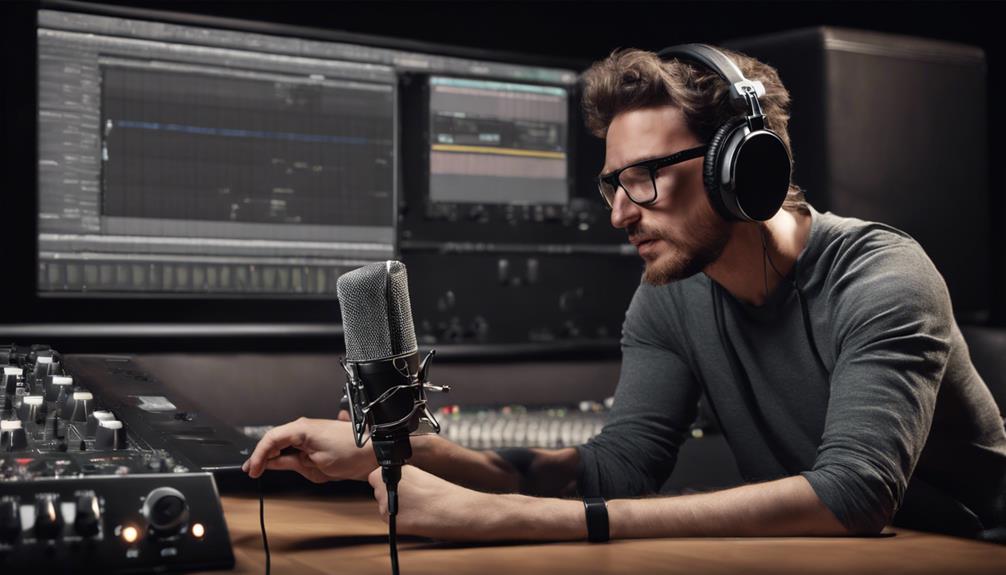
Let's start incorporating various recording techniques to enhance the vocal quality and overall production of the song. Recording multiple takes allows us to capture different nuances and performances, adding depth and authenticity to the vocals. Experimenting with vocal doubling, harmonies, ad-libs, and vocal effects can create creative and unique textures that elevate the song's impact. When editing, remember to fine-tune vocals sparingly to maintain the original authenticity of the performance.
Exploring different microphone techniques is essential in finding the best sound for the vocals. Each microphone can capture specific tonal qualities differently, so don't hesitate to try various options to achieve the desired effect.
Apply Professional Editing
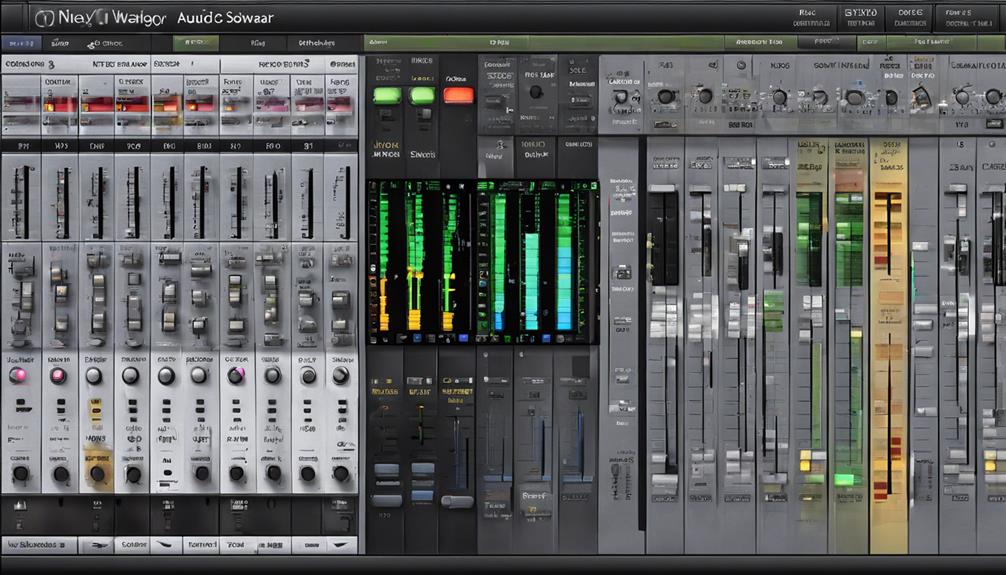
As we explore the world of professional editing, we harness the power of editing software to refine pitch and timing errors in vocals and instruments. When applying professional editing techniques, we focus on enhancing the quality of the recorded tracks through various methods such as:
- Utilizing noise reduction: Removing unwanted background noise to enhance clarity.
- Applying EQ and compression: Balancing frequencies and controlling dynamics for a polished sound.
- Incorporating effects: Adding reverb, delay, and modulation for depth and atmosphere.
- Ensuring seamless connections: Seamlessly blending sections with crossfading or editing techniques.
Frequently Asked Questions
How Do Professionals Record Songs?
When we record songs like pros, we kick things off with a scratch track to set the foundation.
Next, we lay down the rhythm section to establish the beat and groove.
Then, we capture lead instruments or melodies to enhance the overall sound.
Recording vocals is vital as it acts as the focal point.
How Do You Record Like a Pro?
Recording like a pro involves investing in quality equipment and seeking guidance to enhance performance. Multiple recordings, including vocals, rhythm, and harmonies, streamline editing and guarantee control over each instrument.
Trial recordings for drums, bass, vocals, and sound effects refine the final song. A professional approach, whether in a home or rental studio, results in a polished end product.
Utilize these steps to elevate your recording quality and performance like a pro.
What Are the Steps to Recording a Song?
Setting up your home studio with essential gear is important. Start with a scratch track, then layer in rhythm, lead instruments, vocals, and harmonies.
Multiple takes, comping, vocal doubling, and harmonies help capture the best performance. Utilize mixing techniques like balancing faders, panning, EQ, compression, and reverb for a polished sound.
How Do You Record a Perfect Song?
When crafting a perfect song, we lay down a scratch track to get the vibe just right. From there, we build up the rhythm section to set the beat and groove.
Lead instruments and melodies are added to enhance the sound, followed by vocals that bring emotion and clarity. Background vocals or harmonies add depth and complement the main vocals.
It's a step-by-step process that guarantees every element shines in harmony.
Conclusion
To sum up, recording songs like a pro requires attention to detail and proper preparation. By following the steps outlined in this article, you can create high-quality recordings that showcase your talent and creativity.
For example, imagine the exhilaration of hearing your perfectly recorded vocals blend seamlessly with the music, creating a truly memorable and professional sound.
So, set up your space, optimize your acoustics, and get ready to record like a pro!
Composing
Beginner's Guide to Mastering Songs
Take your music to the next level with essential mastering tips for beginners, unlocking the secrets to professional sound quality.

Mastering songs involves refining sound quality and ensuring playback compatibility. It's essential for enhancing music creations. Different from mixing, mastering balances tracks, adjusts volume, panning, and compression to refine the final mix as a whole. DIY mastering offers creative control but may lack professional expertise. Essential equipment includes studio monitors, audio interfaces, and plugins like EQ and compression. Tips for beginners include using reference tracks, avoiding over-processing, and taking breaks to prevent ear fatigue. AI tech offers advanced mastering features. Remember, mastering can't fix a bad mix entirely but aims to enhance sound quality and achieve peak loudness levels.
Key Takeaways
- Use reference tracks for tonal balance and loudness comparisons.
- Avoid over-processing by making subtle and intentional adjustments.
- Take breaks to prevent ear fatigue and maintain objectivity.
- Seek feedback from experienced engineers or utilize online mastering services.
- Focus on tonal balance through effective EQ and compression techniques.
Mastering Vs. Mixing: Key Differences
When we explore the world of music production, mastering and mixing stand out as distinct processes with important differences.
Mixing involves balancing individual tracks to create the final mix, adjusting volume, panning, and compression to achieve the desired sound within a digital audio workstation (DAW).
On the other hand, mastering focuses on refining the final mix as a whole, enhancing clarity, loudness, and preparing tracks for replication and broadcast. Mastering engineers utilize a mastering chain to fine-tune levels, EQ, and dynamic range, ensuring the track is optimized for various playback systems and formats.
Mastering a song is the final step in the music production process, where tracks are arranged in the final sequence and any audio defects are corrected. It's essential to understand the distinctions between mixing and mastering to achieve a polished and professional sound in your music production endeavors.
DIY Vs. Professional Mastering
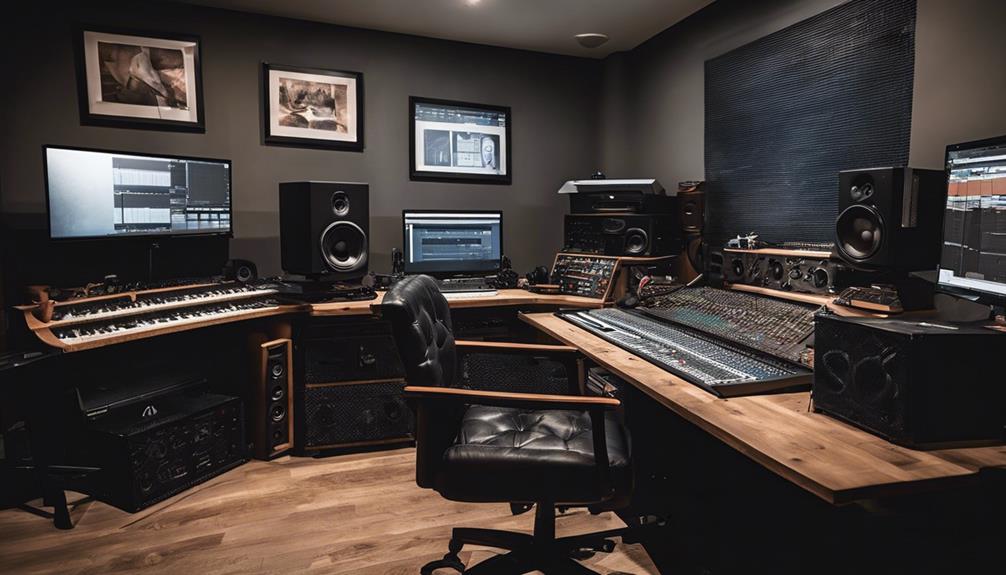
For musicians seeking to release their music, the decision between DIY mastering and professional mastering carries substantial importance in determining the final quality of their tracks.
DIY mastering allows for creative control and cost savings but may lack the expertise and objectivity of a professional mastering engineer. On the other hand, hiring a professional offers the benefit of experienced ears, industry-standard equipment, and a polished final product suitable for commercial release.
Online mastering services can provide a middle ground, with quick turnaround times and affordable pricing. Opting for a professional mastering engineer ensures a fresh perspective, tailored adjustments, and a professional touch that can elevate the quality of the final master.
While DIY mastering can be a valuable learning experience, investing in professional mastering for important releases can greatly enhance the overall quality and impact of the music. Choose wisely to achieve a good and polished outcome that meets industry standards.
Essential Equipment for Mastering
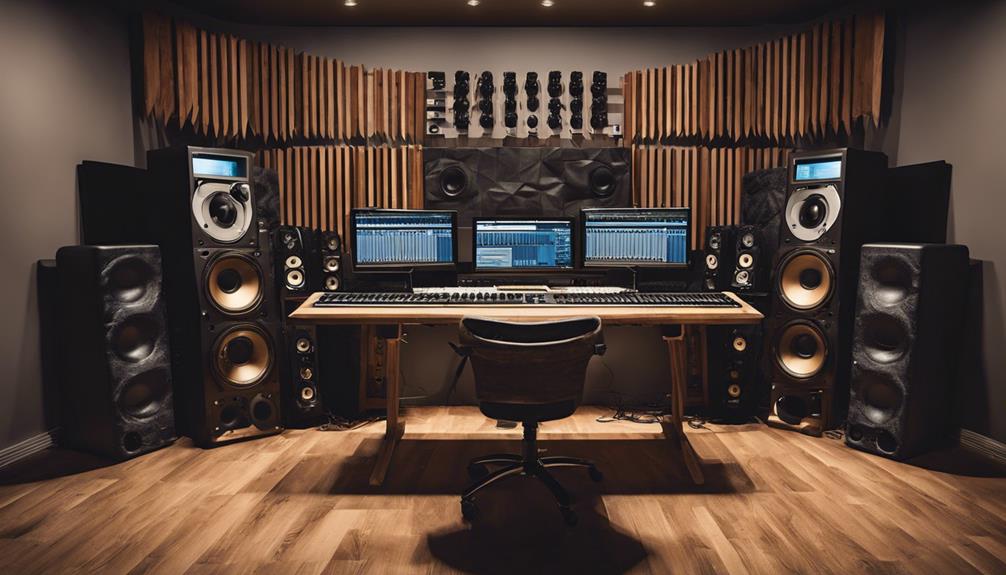
When it comes to mastering music, having the right equipment is essential. High-quality studio monitors allow for accurate sound reproduction, ensuring you can hear every detail in your music.
A dedicated audio interface and quality headphones are also vital components for achieving professional results in your mastering process.
Tools for Mastering
To master songs effectively, one must guarantee they've essential tools such as high-quality studio monitors or headphones to achieve accurate listening. Additionally, utilizing an audio interface for external connections, room treatment materials for a balanced environment, and a digital audio workstation (DAW) software for mastering techniques like EQ and compression are crucial. Incorporating outboard gear such as equalizers, compressors, and limiters can add analog warmth to the process.
Techniques like multiband compression, true peak limiting, and dynamic control using attack and release settings enhance the final product. Widening the stereo image and referencing tracks for comparison further refine the mastering process. Ensuring proper stereo levels and perceived loudness through these tools contributes to achieving professional results.
Studio Monitoring Systems
Investing in reliable studio monitoring systems is imperative for mastering engineers seeking accurate sound reproduction in the mastering process. Calibrated studio monitors are designed to provide a flat frequency response, allowing for detailed analysis of music that may be missed on consumer-grade speakers. These studio monitors play a pivotal role in ensuring that mastering decisions result in professional and consistent outcomes that translate well to various playback systems.
15 Steps to Mastering a Song

Let's begin the process of mastering a song by importing the final mix into a mastering software or DAW. When it comes to mastering in music production, creative decisions play an important role in making sure your song sounds good.
Here are three essential steps to help you master your song effectively:
- Analyze and Adjust: Take a close look at the frequency range and overall level of your mix. Make any necessary fixes like EQ adjustments or dynamic range enhancements to ensure a balanced sound.
- Apply Processing: Utilize tools like compression, EQ, stereo enhancement, and limiting to enhance the quality of your mix. These processes can help achieve a polished and professional sound, bringing your song to its final stage.
- Ensure Consistency: Maintain consistency in tone and level across all tracks in your song. This step is important to make sure that your mastered tracks sound better and translate well across different playback systems and mediums.
Tips for Beginner Song Masters
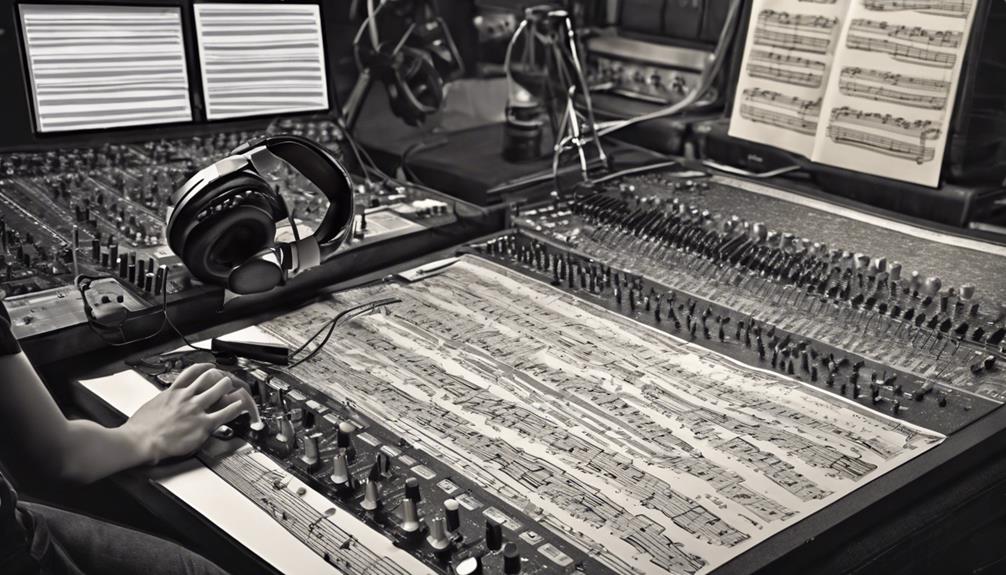
After understanding the basics of EQ and compression in mastering a song, beginners can benefit from implementing key tips to improve their mastering skills.
Using reference tracks is vital for comparing tonal balance and loudness levels, helping achieve a professional sound.
It's important to avoid over-processing by making subtle adjustments that enhance the mix without drastically altering it.
Taking breaks during mastering sessions prevents ear fatigue and guarantees objectivity in decision-making.
Beginners can also explore online mastering services or seek feedback from experienced engineers to enhance their skills.
By focusing on tonal balance and utilizing EQ and compression effectively, beginners can elevate their mastering capabilities and produce high-quality tracks.
Remember, mastering is a skill that develops over time, so patience and practice are key.
Common Mistakes to Avoid

To enhance mastering skills, beginners must steer clear of common mistakes that can hinder the quality of their final mixes. Here are some key pitfalls to avoid:
- Over-compressing: Resist the urge to squash dynamics excessively during mastering. Maintaining the natural ebb and flow of the music is important for a lively and engaging final mix.
- Excessive EQ Boosts: Be mindful of boosting frequencies excessively. Aim for a balanced frequency spectrum to prevent certain elements from overpowering others in the mix.
- Loudness Maximization: Approach loudness maximization cautiously to avoid introducing distortion. Clarity is vital, so make sure that your master maintains its integrity even at higher volume levels.
Getting Started With Emastered

Upon uploading their songs to eMastered, users can access a range of customizable settings for automated mastering processing using AI technology. eMastered, an online mastering platform, leverages AI technology to enhance audio tracks efficiently. By utilizing eMastered, beginners can achieve professional-grade results without extensive mastering knowledge. The platform allows for tailored adjustments such as intensity, clarity, and wideness, ensuring customized outcomes to suit individual preferences. Additionally, users benefit from instant previews of the mastered tracks, enabling quick review and approval before downloading the final versions. eMastered supports various download formats, facilitating easy distribution and playback of the mastered songs. For beginners looking to dive into the world of mastering songs, eMastered provides a user-friendly interface and advanced AI capabilities to streamline the process and elevate the quality of their music effortlessly.
| eMastered Benefits | Description |
|---|---|
| Customizable Settings | Adjust intensity, clarity, and wideness for personalized results. |
| Instant Previews | Review mastered tracks promptly before finalizing. |
| Download Formats | Choose from various formats for convenient distribution and playback. |
| AI Technology | Utilize advanced AI processing for enhanced audio mastering. |
Mastering Questions Answered
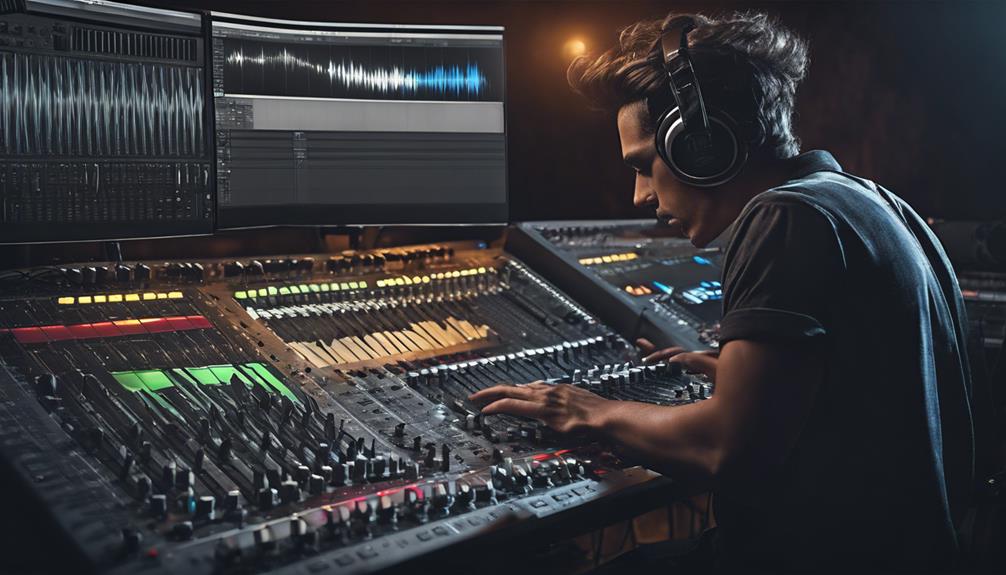
In mastering, understanding key concepts such as the impact of loudness levels and the role of multiband compression can greatly enhance the final quality of a song. Here are some common mastering questions answered:
- Can mastering fix a poorly mixed song?
Mastering can't completely fix a bad mix, but it can enhance the overall sound quality and make it more refined.
- How loud should a mastered song be?
Mastering aims to achieve ideal loudness levels without clipping, ensuring the track is competitive and suitable for different playback systems.
- What is multiband compression in mastering?
Multiband compression is a technique used for mastering the low end of a track, helping to control and enhance the dynamics of specific frequency ranges.
Frequently Asked Questions
How Do You Master a Song for Beginners?
Mastering a song involves refining its sound to achieve a polished final product. We balance frequencies with EQ, control dynamics using compression, and guarantee no distortions with proper levels.
Taking breaks to prevent ear fatigue and fresh listening is essential. Create an ideal listening environment with quality monitors.
These steps will guide beginners in mastering songs effectively.
What Level Should My Song Be Before Mastering?
Before mastering, aim for an average peak level of -6 dB to -3 dB to allow room for processing. Keep the loudest sections below -0.3 dB to prevent clipping.
Avoid excessive loudness to prevent artifacts in mastering. Consistent levels maintain balance and prevent sudden volume changes.
Use reference tracks for perspective.
What to Do Before Mastering a Song?
Before guaranteeing a song, we make sure our mix is well-balanced and free of any issues like clipping or distortion. We check track levels to avoid overpowering elements.
We create an ideal listening environment with high-quality headphones or studio monitors. Taking breaks prevents ear fatigue. Using reference tracks helps compare tonal balance.
These steps guarantee an excellent final master, reflecting our dedication to quality and innovation in music production.
How Hard Is It to Master Songs?
Mastering songs can be challenging, requiring technical skills and critical listening. It takes time and practice to develop the expertise for effective mastering.
Understanding tools like EQ, compression, and limiting is essential. Achieving ideal loudness levels without sacrificing quality is key. Attention to detail, consistency, and enhancing the overall sound without over-processing are indispensable.
It's a demanding process, but with dedication and learning, mastering songs becomes more manageable.
Conclusion
In mastering songs, we're like sculptors shaping a masterpiece from raw materials. With patience and practice, we can refine and polish our creations to perfection.
Remember, mastering is an art form that requires dedication and attention to detail. By following the steps outlined in this guide, you can unleash the full potential of your music and bring it to life in ways you never imagined.
Keep honing your skills and let your creativity flourish.
Composing
7 Pro Steps for Remixing Songs
Open the door to mastering the art of remixing songs with these 7 pro steps – your next hit could be just a remix away!

When remixing songs, start by analyzing popularity, genre suitability, and securing rights. Plan your direction, establish clear goals, and map out your remix approach. Identify key and BPM for seamless integration and musical cohesion. Prepare stems meticulously for manipulation, adjusting pitch and effects for uniqueness. Choose elements wisely to maintain the remix vision and genre consistency. These steps guarantee a dynamic remix that captivates your audience. Master all seven professional steps to enhance your remixing skills and craft music that resonates with listeners. Elevate your remixing game with these expert strategies.
Key Takeaways
- Analyze popularity, genre, and impact of the original song for remix suitability.
- Set clear objectives and goals to guide the remix process effectively.
- Identify key and BPM to ensure harmonious integration in the remix.
- Prepare stems meticulously for efficient manipulation and arrangement.
- Select elements that align with the remix vision, style, and audience preferences.
Track Selection
When selecting tracks for remixing, we prioritize analyzing the popularity, genre, and potential impact of the song. It's essential to take into account the original song's appeal and how it aligns with our target audience's preferences. By evaluating these factors, we can determine the remix's potential success and resonance within its genre. Additionally, obtaining legal permission from rights holders before embarking on the remix process is a necessary step to guarantee a smooth and ethical production journey.
Before choosing a song for remixing, we explore its stems to fully grasp the music's structure and components. This allows us to identify opportunities for creative reinterpretation while staying true to the essence of the original piece. By carefully examining trendy tracks, we can assess the level of competition in remix contests and strategize our approach to stand out in a crowded field. Our aim is to remix songs that not only highlight our innovation and artistry but also deeply connect with our audience, creating a memorable musical experience.
Direction Planning

Before undertaking a remix project, it's essential to establish the direction and vibe you wish to achieve. Planning how to revamp the original track and enhance specific elements will help steer your creative process.
Setting Clear Objectives
In setting clear objectives for a remix, we meticulously outline the specific elements to transform or enhance in the original song. By defining our goals upfront, we steer the remix towards our desired outcome and maintain a sense of direction throughout the process.
This planning stage is vital as it guides our selection and manipulation of stems to craft a unique and innovative remix. Our objectives may involve adding new instruments, adjusting the tempo, or restructuring the song to offer a fresh interpretation.
With a clear roadmap in place, our remix can stay focused and cohesive, resulting in a more successful final product that resonates with our vision for the project.
Structuring Workflow Efficiently
After defining our objectives for the remix, the next step involves structuring our workflow efficiently by outlining the elements to incorporate and creating a timeline for each stage of the process.
- Start by setting a clear direction and vision for your remix to guide your workflow effectively.
- Outline the elements you want to incorporate, such as vocals, instruments, or effects, to stay focused during the remixing process.
- Create a timeline or schedule to allocate time for each stage of remixing, from selecting stems to finalizing the mix.
- Use project management tools or software to organize your workflow, track progress, and make sure all tasks are completed.
- Regularly review and adjust your workflow structure to optimize efficiency and creativity in your remixing projects.
Efficient workflow structuring is key to creative optimization in remixing songs.
Key and BPM Identification
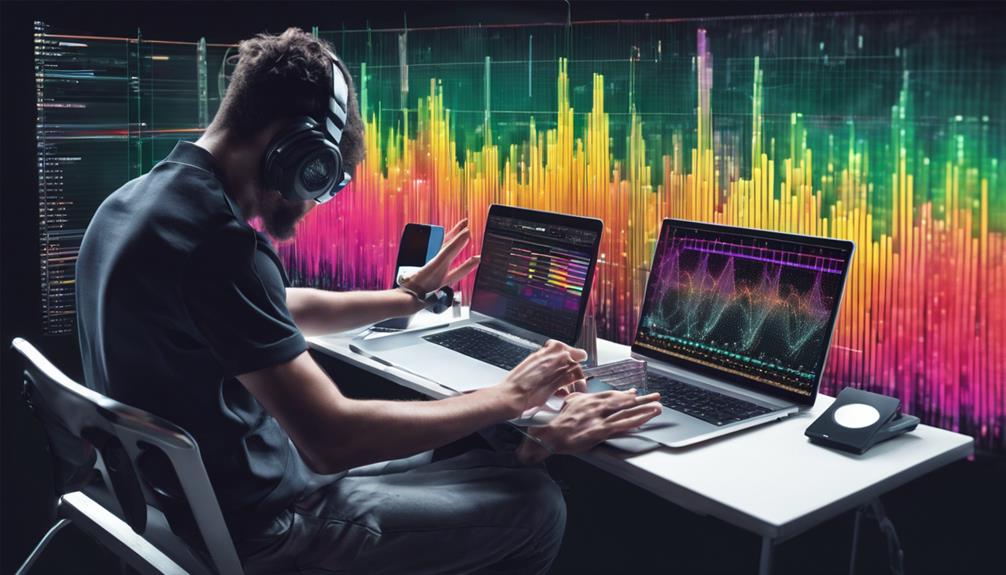
Identifying the key and BPM of a song is essential for remixing, as it forms the foundation for harmonious integration of new elements. The key of a track reveals the scale and chord progressions used in the original song, guiding you to select remix elements that fit seamlessly. Similarly, knowing the BPM (beats per minute) of the original track is pivotal for syncing your remix elements accurately.
Utilizing tools like digital audio workstations (DAWs) and BPM detection software can aid in precisely determining the BPM, ensuring a smooth shift between the original and remixed versions. Matching the key and BPM of the original song in your remix project is crucial for maintaining musical cohesion, integrity, and harmony.
This attention to detail not only enhances the overall quality of your remix but also contributes to the musical integrity and coherence of the final product, elevating the listening experience for your audience.
Stem Preparation
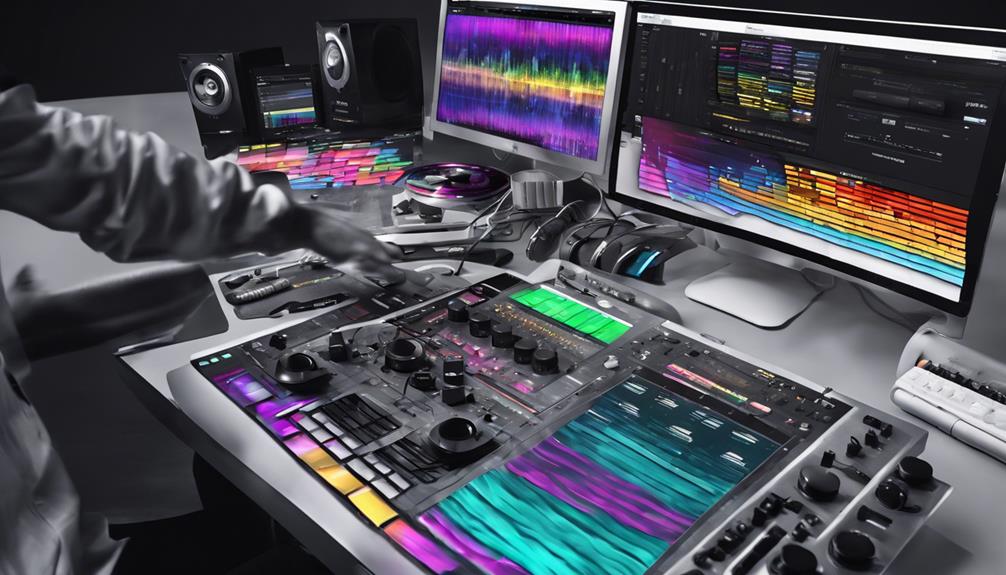
Having successfully identified the key and BPM of the song, the next step in our remixing process is preparing the stems for efficient manipulation and rearrangement. Stems, individual audio tracks extracted from the original project file, provide flexibility in remixing by allowing us to isolate and manipulate specific elements.
When dealing with vocal stems, which are isolated vocal tracks, adjusting pitch, timing, and effects becomes essential for creating a unique remix. Proper stem preparation involves organizing and labeling these audio tracks correctly, ensuring that each element is easily identifiable for manipulation.
Tools like iZotope RX can be invaluable in effectively isolating and working with vocal stems, enhancing the remixing process by providing advanced capabilities for pitch correction and enhancement. By taking the time to prepare and label stems appropriately, remixers can streamline their workflow and have greater control over the individual elements of a song during the manipulation phase.
Element Selection
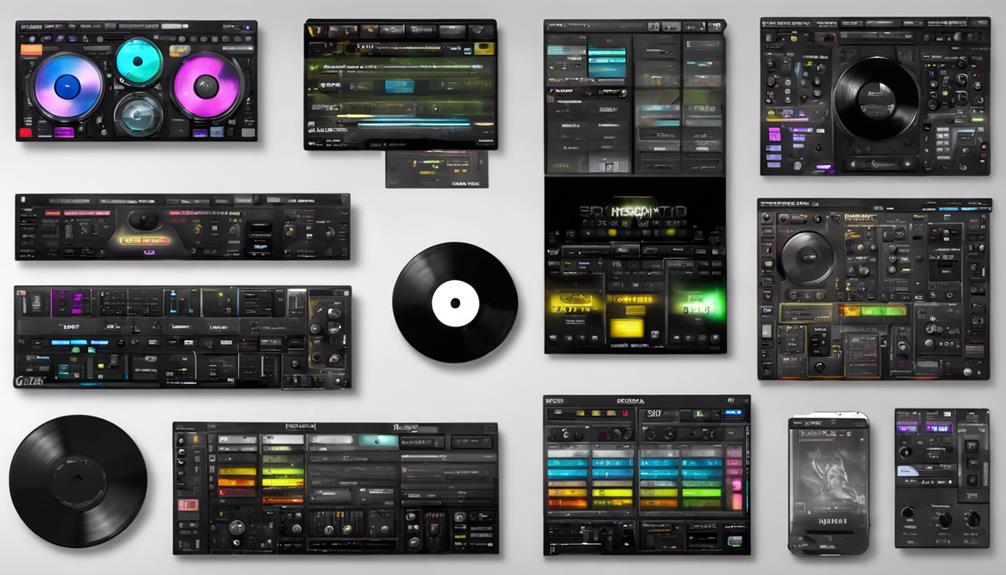
For a successful remix, carefully selecting the elements that align with our remix vision and style is vital. When choosing elements for a remix, it's important to maintain consistency with our creative direction and guarantee that the quality remains paramount. Elements such as vocals, drums, and melodies should be chosen thoughtfully, as these can be manipulated to bring a fresh perspective to the original track.
Considering the genre and mood of the original song is also key in guiding our element selection process. By experimenting with different combinations of elements, we can craft a remix that isn't only unique but also engaging for our audience.
Remix Crafting
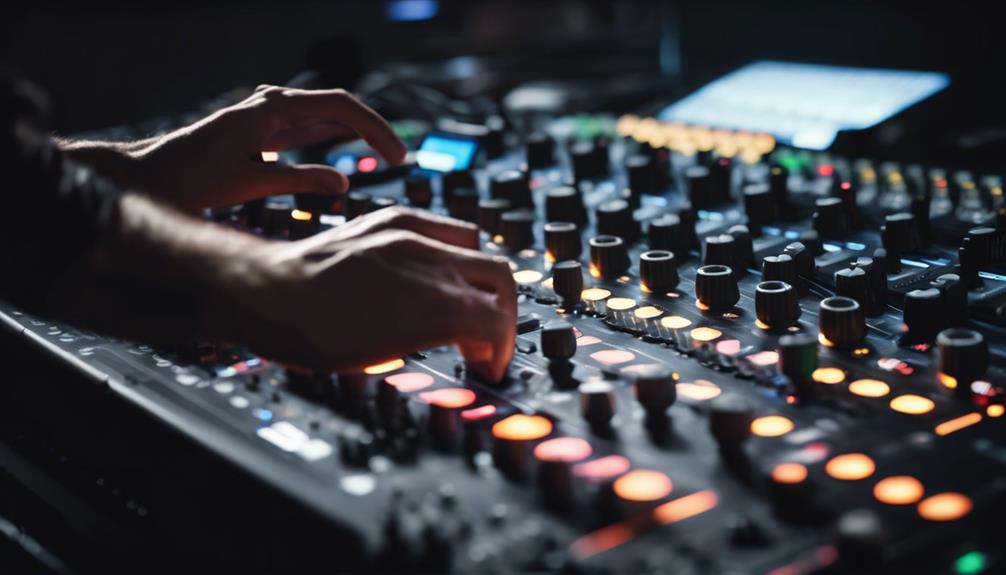
Crafting a compelling remix involves skillfully altering the original elements of a song to create a version that's uniquely our own.
In remix crafting, we explore the intricacies of transforming music by changing textures, tones, adding instruments, adjusting the drum beat, and even tweaking the tempo.
Incorporating our own elements, such as distinct drum beats, vocals, or instruments, is vital for breathing new life into the track.
Balancing the levels of various tracks and effects while mastering our remix skills is essential to achieve a polished outcome that captivates listeners.
Infusing our personal style and creativity into the remix is what sets it apart and makes it a true reflection of our artistry.
Through remix crafting, we've the opportunity to showcase our innovation and push the boundaries of musical expression.
Mixing and Mastering

As we progress from remix crafting, our focus now shifts towards the critical elements of mixing and mastering in the remixing process. When it comes to mixing, it's all about blending the individual stems and elements of a remix to achieve a balanced and professional sound. This involves adjusting levels, panning, EQ, and effects to guarantee clarity and cohesion in the final product. On the other hand, mastering is the last step where the overall sonic quality, loudness, and consistency of the remix are polished to stand out on various playback systems. To help you understand the significance of mixing and mastering, let's explore the key aspects in the table below:
| Mixing | Mastering |
|---|---|
| Blending individual stems | Enhancing sonic quality |
| Adjusting levels for balance | Ensuring loudness |
| Using EQ and effects | Providing consistency |
| Achieving professional sound | Polishing the final mix |
Frequently Asked Questions
What Are the Rules for Remixing Songs?
When it comes to remixing songs, understanding copyright rules is essential. Without permission, remixing can lead to legal issues.
Artists may offer stems or host remix contests to encourage lawful remixes. Following guidelines protects the original work and guarantees a smooth remixing process.
What Are the Rules for Remixing?
When remixing songs, our top priority is respecting copyright laws. Obtaining permission from the original artist or rights holders is essential. Failure to do so can lead to legal consequences like takedown notices or lawsuits.
Properly crediting the original artist and obtaining licenses are vital steps. By following guidelines and obtaining clearance, we guarantee a legal and ethical approach to remixing songs.
It's like maneuvering through a musical legal labyrinth to create something new and exciting!
How Do You Make an Official Remix of a Song?
To make an official remix of a song, we secure permission from the original artist or label. This typically involves working directly with stems or parts of the original song provided by them.
Labels may also reach out to established producers or artists for official remixes. These remixes are released with proper licensing and credits, ensuring fair royalty distribution.
Creating an official remix can greatly enhance our visibility, credibility, and opportunities in the music industry.
What Makes a Great Remix?
When crafting a great remix, it's all about infusing new elements while honoring the original vibe. By adding a unique twist and creative arrangements, we can engage listeners with fresh sounds and emotions.
A successful remix evokes excitement, inspires movement, and breathes new life into the original track. Through innovative instrumentation and effects, we elevate the remix to greatness, offering an engaging experience that resonates with the audience.
Conclusion
To sum up, mastering the art of remixing songs takes time, practice, and dedication.
While it may seem overwhelming at first, following these seven pro steps can help streamline the process and elevate your remixes to the next level.
One common objection may be the amount of technical knowledge required, but with patience and perseverance, anyone can learn to remix songs like a pro.
Keep experimenting, stay creative, and most importantly, have fun with it!
Composing
Rearrange Songs in Your Spotify Playlist: 10 Simple Steps
Here's a sneak peek: Harness the power of Spotify's drag-and-drop feature to effortlessly rearrange your playlist order. Keep reading for 10 simple steps!
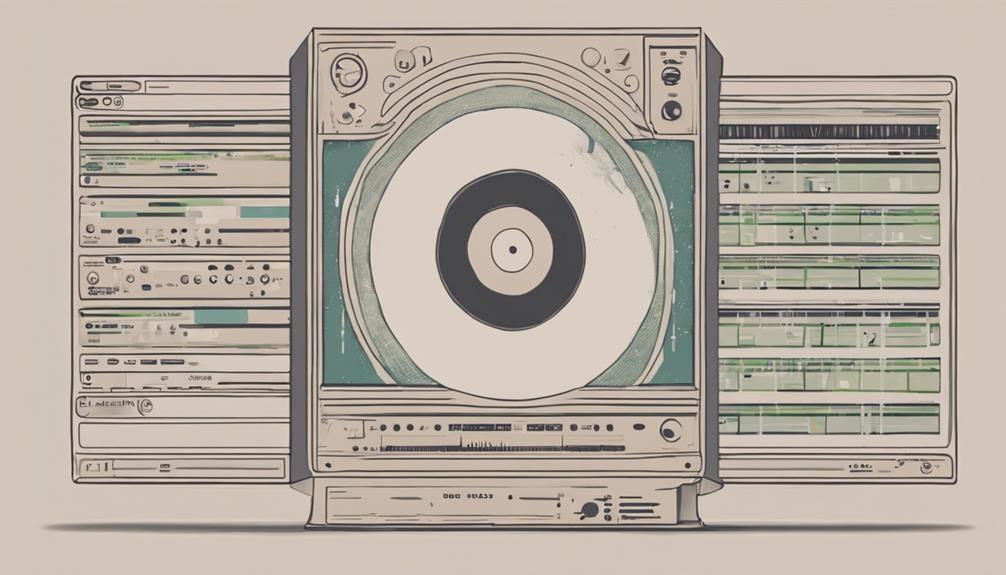
Rearranging songs in your Spotify playlist is simple. First, open Spotify and head to 'Your Library.' Choose the playlist to rearrange. Within editing mode, tap and hold a song to move it where you want. Spotify's drag-and-drop feature makes this a breeze. Remember to save your changes to keep the new order. On mobile, tap the three dots, select 'Edit Playlist,' then drag songs around. Enjoy crafting your personalized playlist order hassle-free. For more detailed steps on customizing your playlists for a seamless listening experience, explore the thorough guide provided.
Key Takeaways
- Access 'Your Library' and select the playlist
- Enter editing mode and use drag-and-drop feature
- Save changes to preserve new song order
- Utilize mobile app for easy rearranging
- Enjoy a personalized listening experience
Access Your Spotify Playlist
To access your Spotify playlist, open the Spotify app on your device and head to the 'Your Library' section. Whether you're on your desktop or mobile device, locating your playlists is a breeze. Once you've found the playlist you wish to edit, simply click on it to enter the playlist customization mode. Here, you can see the current order of songs and make changes as needed.
Customizing your playlist name is also a straightforward process. Within the playlist editing mode, look for the option to rename your playlist. Click on the current name to edit it to something more fitting or creative. This feature allows you to personalize your playlists and give them unique titles that resonate with you.
On both desktop and mobile versions of Spotify, the playlist customization tools are intuitive and user-friendly. Whether you're rearranging songs or updating the playlist name, the process is designed to be simple and efficient, enhancing your overall music listening experience.
Select the Playlist to Rearrange
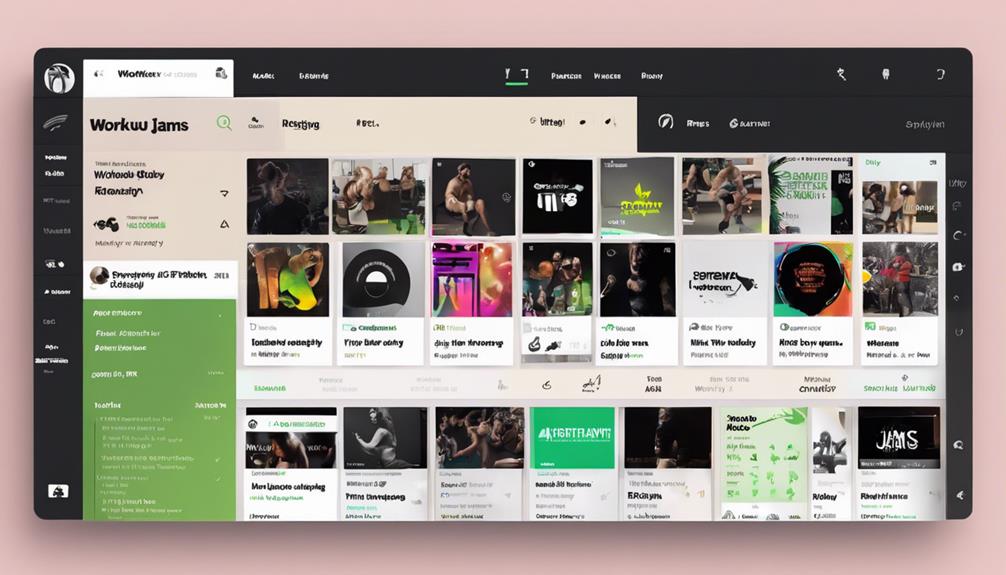
When rearranging songs in your Spotify playlist, we start by choosing the desired playlist.
By selecting the playlist and clicking 'Edit,' we can utilize the drag-and-drop feature to rearrange the songs effortlessly.
Once satisfied with the new order, remember to save the changes made to enjoy your personalized music lineup.
Choose Desired Playlist
How can we identify the playlist we want to rearrange in our Spotify library?
To choose the desired playlist for rearranging songs, open your Spotify app and navigate to the 'Playlists' section. Look for playlists you have created, as only these can have their song order edited. Remember, collaborative or curated playlists by Spotify can't be rearranged. Make sure you have editing permissions for the specific playlist you wish to adjust.
Once you've located the playlist you want to work on, you're ready to move on to the next steps in rearranging the song order. Selecting the right playlist is the first step toward crafting a personalized listening experience tailored to your preferences.
Use Drag-And-Drop Feature
Let's utilize the drag-and-drop feature in Spotify to rearrange songs in our selected playlist. Access your playlist on the Spotify mobile app to begin the process.
Simply tap and hold a song, then drag it to the desired position within the playlist. Once you have the song in the right spot, release your finger to drop it and rearrange your playlist effortlessly.
This drag-and-drop functionality offered by Spotify makes customizing the order of songs in your playlist a breeze. Whether you want to bring your favorite tracks to the top or create a specific mood with the song sequence, rearranging your playlist using the drag-and-drop feature gives you full control over your listening experience.
Enjoy crafting your perfect playlist arrangement with this intuitive tool!
Save Changes Made
Choosing the playlist is vital to guarantee that the changes made to your rearranged Spotify playlist are saved. When saving custom changes, it's important to have the correct playlist selected for the modifications to take effect.
To make sure your desired song order is maintained, follow these steps:
- Select the playlist you want to rearrange.
- Confirm the playlist selection before proceeding.
- Save changes to secure your newly arranged song order.
- Double-check that the custom changes are reflected in the playlist.
Enter Edit Mode

To rearrange songs on Spotify, entering Edit Mode is essential. This mode allows us to easily shift songs around in our playlists.
Select Desired Song
When entering edit mode on Spotify to rearrange songs in your playlist, the first step is selecting the desired song you wish to move. Here are some tips to help you with this process:
- Look for the three dots icon or the edit option to access the editing features.
- Once in edit mode, you can easily drag and drop the selected song to its new position in the playlist.
- Make sure to save the changes after rearranging the songs to update the playlist order.
- By following these steps, you can efficiently rearrange your playlist to suit your preferences and create a personalized listening experience.
Move Song to New Position
After selecting the desired song in your Spotify playlist, the next step is to enter Edit mode to move the song to a new position.
In Edit mode, you have the power to rearrange songs with a simple drag and drop feature, allowing you to customize the order of your playlist effortlessly.
This innovative tool provided by Spotify gives you the freedom to manage your playlist according to your preferences, ensuring a seamless listening experience.
By utilizing Edit mode, you can easily modify the sequence of songs in your playlist, making playlist management a breeze.
Take control of your Spotify playlists and create the perfect musical journey by mastering the art of rearranging songs with this user-friendly feature.
Drag and Drop Songs
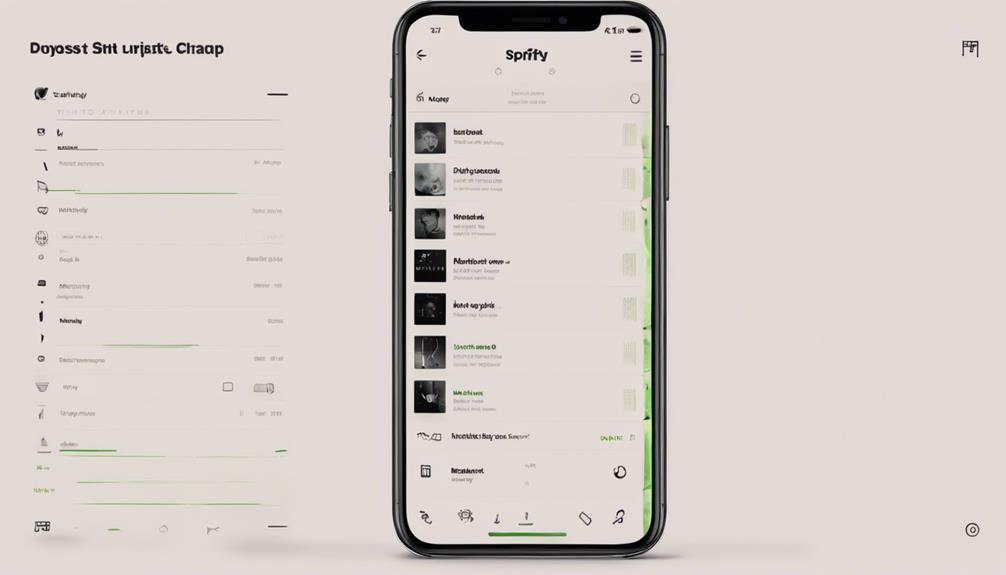
By dragging and dropping songs in your Spotify playlist, you can effortlessly rearrange the track order to suit your preferences. Here are some simple steps to help you make the most of this feature:
- Select the Song: Click and hold on the song you want to move.
- Move the Song: Drag the song up or down within the playlist to the desired position.
- Indicator Line: A white line will show you where the song will be placed once you release it.
- Available Platforms: This drag and drop functionality is accessible on both the desktop app and the mobile version of Spotify.
With these easy-to-follow instructions, rearranging songs in your Spotify playlists becomes a seamless and enjoyable experience. Whether you're crafting the perfect workout playlist or curating a mood-setting mix, the drag and drop feature empowers you to customize your listening experience effortlessly.
Rearrange Songs Within a Playlist

When arranging songs within a playlist on Spotify, we can easily drag and drop them to customize the order. This feature allows us to create a personalized playlist flow that aligns with our listening preferences.
It's a convenient way to make sure our favorite tracks play in the order we desire.
Drag and Drop
To rearrange songs within a Spotify playlist, simply click and hold a song, then drag it to the desired position in the playlist. This drag and drop feature makes organizing your playlist a breeze. When you move a song, a white line indicator shows where it will be placed once released. Here are some key points to keep in mind:
- Click and hold the song you want to move.
- Drag the song to where you want it in the playlist.
- Watch for the white line indicator to guide you.
- Release the song to reorder your playlist effortlessly.
With these simple steps, your Spotify playlist will be reordered exactly how you want it.
Custom Playlist Order
After mastering the drag and drop feature for rearranging songs in your Spotify playlist, the next step is to explore custom playlist order options to further tailor your music listening experience.
By utilizing the edit option on both desktop and mobile devices, you can create a personalized sequence by adjusting the song order within your playlist. This custom order feature allows you to curate the perfect flow of tracks to match your mood or style.
Simply select the song you want to move, drag it to the desired position, and enjoy your newly arranged playlist. Customizing the order of songs within your playlist not only adds a personal touch but also enhances your overall listening pleasure, making each music session uniquely yours.
Save Your Changes

Let's make sure that our customized song order is maintained by saving our changes in the Spotify playlist. Here are some steps to help you save your rearranged songs effectively:
- Click on the 'Save' or 'Done' button after rearranging songs to apply the changes.
- Saving the playlist guarantees that the new order of songs is updated across all your devices.
- Remember, failure to save changes may cause the playlist to revert to its previous order.
- Make sure to save your edits before exiting the playlist editing mode to preserve your customized order.
Rearrange Songs on Spotify Mobile App

After saving your customized song order in your Spotify playlist, efficiently rearrange songs on the Spotify mobile app by tapping on the three dots icon.
Select 'Edit Playlist' and then press and hold on a track to drag it to a new position. This simple process allows for quick and personalized playlist organization.
The Spotify mobile app provides a seamless experience for users to rearrange songs effortlessly. By dragging tracks to their preferred spots, listeners can tailor their playlists to suit their mood or occasion.
The intuitive interface enhances the music listening experience on the go, making playlist management a breeze. Whether you want to move your favorite tracks to the top or create a specific order for a themed playlist, the Spotify mobile app offers a user-friendly solution for rearranging songs.
Stay in control of your music collection with easy-to-use tools for playlist customization.
Use the Mobile App Drag and Drop Feature

We can easily rearrange songs in our Spotify playlist on the mobile app by utilizing the drag and drop feature. This functionality simplifies the process, allowing us to customize our music experience effortlessly. Here's how you can make the most of this feature:
- Press and hold a track in your playlist.
- Drag the track to your preferred spot for easy reordering.
- Enjoy the intuitive customization of song order with a simple touch.
- Visually see the track moving as you drag it to a new location within your playlist.
The drag and drop feature on the Spotify mobile app enhances the user experience by making rearranging songs quick and user-friendly. It gives us the flexibility to organize our playlists according to our preferences, ensuring that our music is always in the perfect order.
Save Changes on Mobile

To save changes to your playlist on mobile, just make sure that you have dragged the songs to their preferred positions. Once you have rearranged the songs in your playlist, the changes will be automatically saved.
It's crucial to confirm the songs are in the desired order before exiting the playlist editing mode. By promptly saving the changes, your playlist will accurately reflect the new song order. This process guarantees that your customized playlist is ready for you to enjoy with the songs arranged to your liking.
Remember, utilizing features like the Spotify Music Converter can enhance your playlist editing experience on mobile, making it more efficient and convenient. So, don't forget to save those changes after you've meticulously rearranged your songs.
With just a few simple steps, you can have a perfectly organized playlist tailored to your preferences, ready to accompany you wherever you go.
Enjoy Your Newly Arranged Playlist

With your playlist now rearranged, immerse yourself in a rejuvenating listening experience tailored to your tastes. As you explore your newly organized Spotify songs, make sure to follow these steps to fully enjoy your music:
- Select the Edit option on your playlist to access the song arrangement feature.
- Make sure to drag and drop the songs to their desired position within the playlist.
- Explore the seamless flow of music you've created by customizing the order of songs.
- Enhance your music discovery process and investigate new tracks more efficiently with your personalized playlist.
Frequently Asked Questions
How Do I Rearrange Songs in Spotify Playlist?
When it comes to rearranging songs in your Spotify playlist, it's a breeze. Simply tap on the three dots menu in the app and select 'Edit Playlist.'
Then, all you need to do is drag and drop the songs to the positions you want. It's quick and easy to customize your playlist just the way you like it.
Enjoy the freedom to create the perfect playlist for any mood or occasion!
How Do I Organize My Songs on Spotify?
To organize our songs on Spotify, we can manually rearrange them in our self-created playlists. Simply open Spotify on desktop or mobile, access the three dots menu, select Edit, and drag songs to change their order.
For bulk playlist organization, we can sort songs by title, artist, album, or date, then cut and paste to reorder. Spotify supports rearrangement by Date Added, Album, Artist, and Title, allowing us to customize our music experience effortlessly.
Is There a Way to Shuffle the Order of Songs in a Spotify Playlist?
Yes, there's a way to shuffle the order of songs in a Spotify playlist. By simply enabling the shuffle feature, Spotify will randomize the sequence of songs within your playlist, offering a fresh listening experience.
This option is user-friendly and adds spontaneity to your music selection. Try it out to inject some excitement into your playlist curation.
How Do I Edit Songs on Spotify?
When editing songs on Spotify, we can easily rearrange them in playlists for a customized experience.
Simply open the app, access the three dots menu, and select Edit.
Then, drag the song to change its order within the playlist on both desktop and mobile devices.
This process allows us to curate our listening journey effortlessly, like rearranging furniture in a room to create the perfect ambiance.
Conclusion
To sum up, rearranging songs in your Spotify playlist can be a breeze with these simple steps.
Access, select, and drag to create a new order that suits your mood.
Whether on your computer or mobile app, the process is quick and easy.
So, save your changes, sit back, and soak in the sounds of your newly arranged playlist.
Happy listening!
-
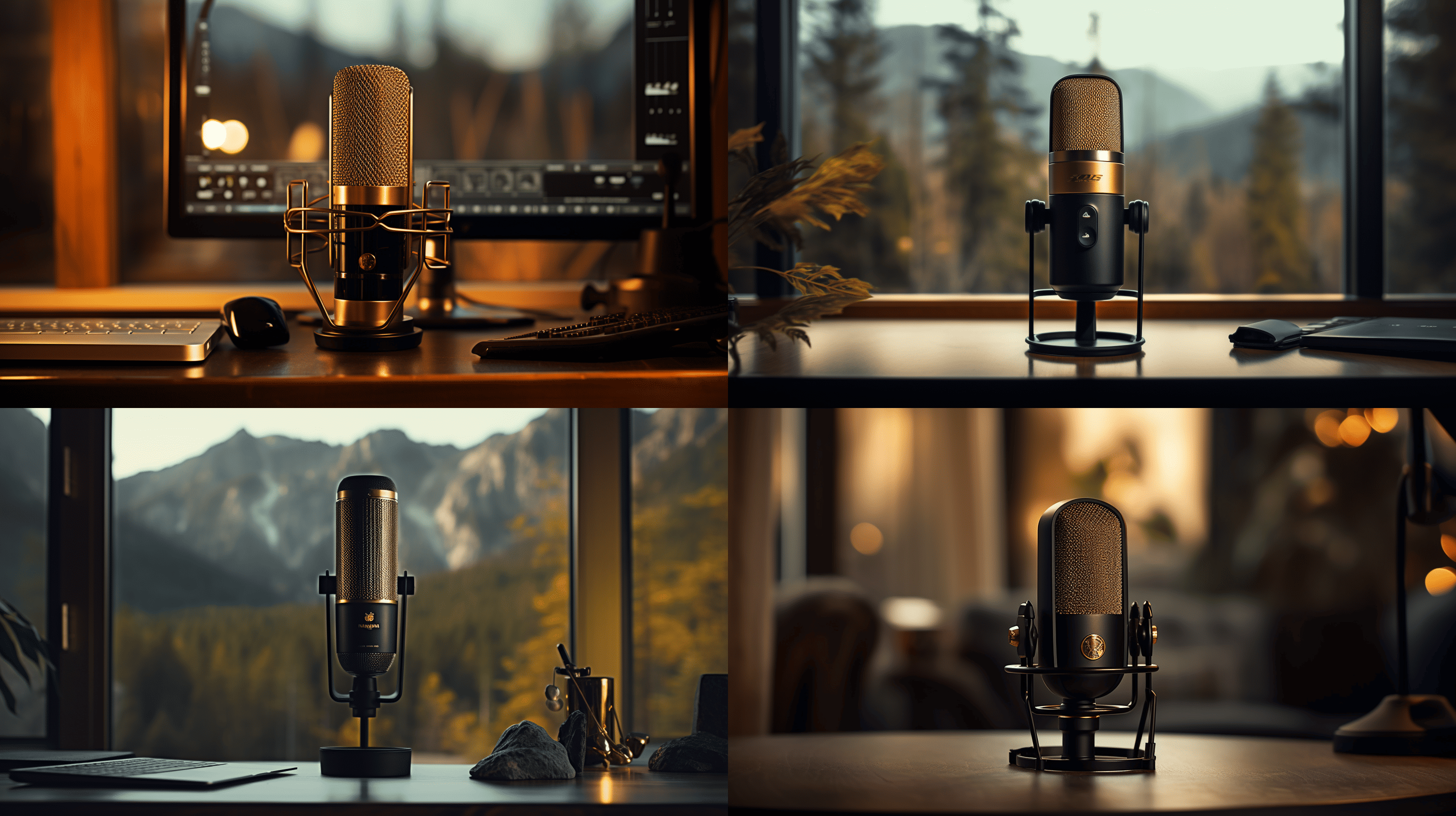
 Microphone1 month ago
Microphone1 month agoUnleash Your Inner Podcaster: Discover the Best Microphone for Crisp, Clear Audio
-

 Music Theory1 month ago
Music Theory1 month agoUnlocking Nature’s Harmony: The Power of 432 Hz Frequency in Sound & Music for Enhanced Living and Well-Being
-

 Sound Design1 month ago
Sound Design1 month agoWhat Is the Difference Between a Sound Engineer and A Sound Designer?
-

 Native Instruments Kontakt1 month ago
Native Instruments Kontakt1 month agoVOCAL AI – Animated Intelligence: The Ultimate Vocal Playground
-

 Sound Design1 month ago
Sound Design1 month agoWhy Sound Engineer
-

 Composing1 month ago
Composing1 month agoMUTILATED NOISE by SampleTraxx: The Next Generation Sound Collection
-

 Audio Production3 weeks ago
Audio Production3 weeks agoUnleashing Sound Therapy: Incorporating Acoustic Design in a Wellness Centre
-

 Expert Guides1 month ago
Expert Guides1 month agoHow Do You Become a Sound Designer














